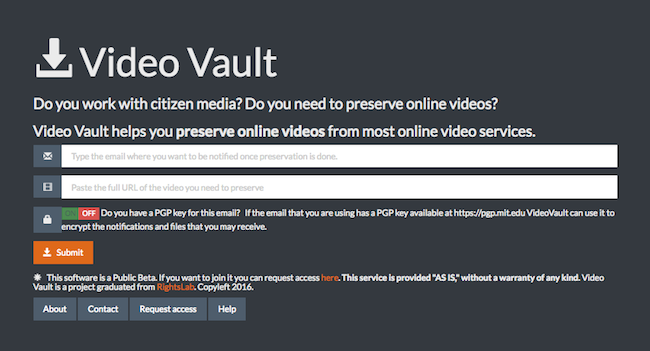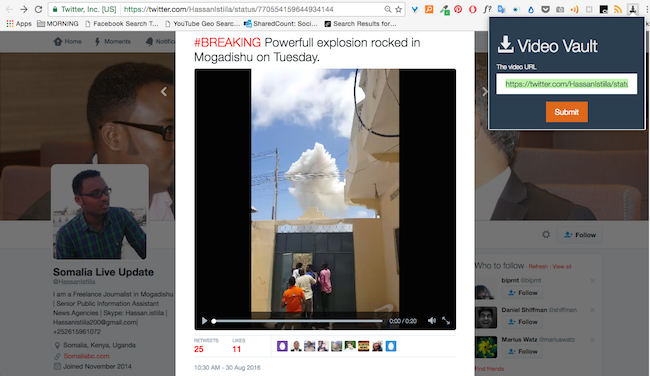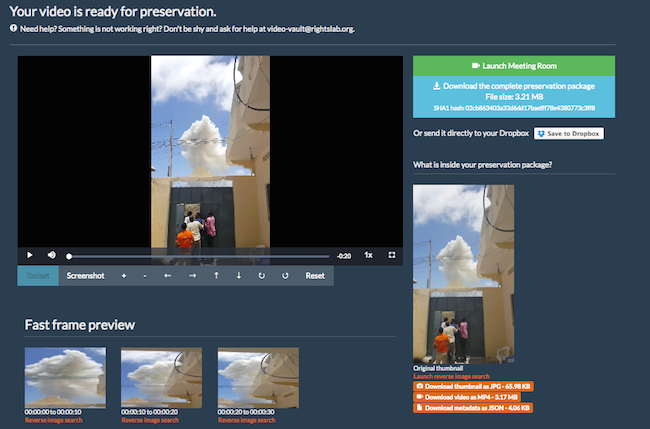What is Video Vault? A tool to help archive videos online, with extra facilities for verification and collaboration.
Do I have to pay for it? No, once your email address has been approved to use the service you’re good to go.
So how do I use it? When half the world has a video camera in their pocket at any given time, many big news events are captured on video and uploaded to the internet. The trouble is, they don’t always stay online and many online video players aren’t that conducive to helping journalists verify the content of the footage itself. Video Vault can change that.
You can request access to Video Vault by submitting your email address and a little information about why you want to use the tool. If you are a journalist, human rights worker or similar, your request will be approved and you can get to work.
Found a newsworthy video you want to preserve for more detailed study? Submit the link and your email address on the Video Vault home page and you will be emailed a link to a unique page with a range of options to investigate the footage.

Users can activate PGP encryption on the notifications and files they receive from Video Vault
Better still, add the Video Vault browser extension to Chrome and click the icon in the browser’s toolbar to automatically submit a URL for preservation.
The browser extension currently works for any video posted to YouTube, Facebook or Twitter, but the site itself will process a video from “hundreds, if not thousands” of sources, according to its creator, Enrique Piracés, including LiveLeak, Instagram, VKontakte, Vimeo, and more.

Archiving this video allegedly featuring footage from a bombing in Mogadishu is a quick process with the Video Vault browser plugin
After submitting a video to be archived you should receive a unique link to analyse the footage on Video Vault. Here you can save the video to Dropbox, download it directly or download the component parts: a thumbnail image, the video’s metadata as it appeared online, just the footage or just the audio.
Video Vault also provides thumbnail images to carry out a reverse image search directly from the page, similar to YouTube Data Viewer, and a toolbar to slow down playback, speed it up, zoom in on particular areas, rotate the video, and take a snapshot of particular moments.
Finally, and perhaps most impressively, you can send the link to colleagues and click the green ‘launch meeting room’ button to start a video conference call and discuss the video together.

Video Vault features many functions to help verify archived footage
Piracés built Video Vault as “an act of solidarity with human rights practitioners and journalists,” he told First Draft, “to help them be more efficient [and] more effective.”
Users don’t need to create an account or a profile, like with many other services, as Piracés “doesn’t want to have your passwords”, he said, and would rather think of users as peers than customers.
He intends to add more functions to Video Vault in the near future, including a screenshot of the webpage the video appeared on; “trusted timestamping” to prove a video existed at a certain time before it was deleted; and, if users think a video should be publicly available, submitting videos to the Internet Archive to be preserved in posterity.
Further down the line, he wants to add a “fast frame preview” so users can scan videos for noteworthy moments; the ability to draw on footage directly in the web page to highlight key areas; and even integrate an RSS-like monitoring system to automatically archive videos from YouTube channels.
Online reporting increasingly means working with footage created by eyewitnesses or other individuals, footage which newsrooms have no direct control over. Almost by definition, this makes it “fragile”, said Piracés, in the context of its use in reporting the facts and bearing witness to current events.
“The point is that at some point some of these videos will be very valuable,” he said, “and at some point they will disappear.”
Some people may have very good reasons for removing a video, and newsrooms should be aware of the risks that come with identifying uploaders or individuals that appear in the footage.
But for journalists, human rights workers, or anyone else working with newsworthy videos which surface online, Video Vault could be an invaluable tool in the locker for newsgathering and verification.
Follow First Draft on Twitter or Facebook for the latest updates in social newsgathering, verification and more.
UPDATE: This article previously referred to Piracés as “a media and human rights program manager at Carnegie Mellon University” (CMU). Piracés fulfils this role at CMU, but Video Vault is in no way associated with the university and was built by Piracés as an independent project.



